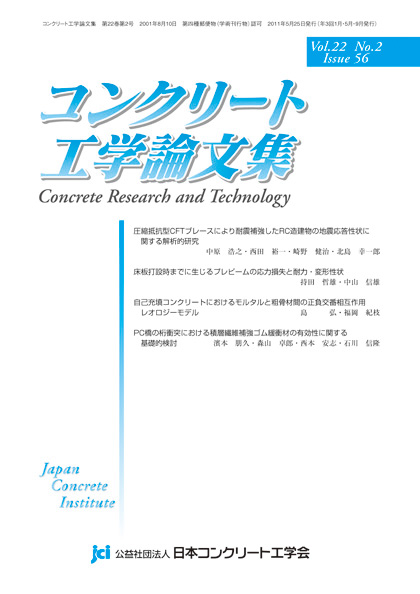All issues

Volume 22 (2011)
- Issue 3 Pages 3_1-
- Issue 2 Pages 2_1-
- Issue 1 Pages 1_1-
Volume 22, Issue 3
Displaying 1-5 of 5 articles from this issue
- |<
- <
- 1
- >
- >|
-
Satoru Yamamoto, Kenkichi Tashiro, Yoshiko Tatebayashi, Kouji Ishii, H ...2011Volume 22Issue 3 Pages 3_1-3_11
Published: 2011
Released on J-STAGE: December 15, 2011
JOURNAL FREE ACCESSThe criterion of 100 mV depolarization is adopted in many cases of cathodic protection (CP) for reinforced concrete under atmospheric conditions. This criterion is very applicable and its validity is confirmed in many cases. However, it is not suitable for members under high moisture conditions such as upper members of piers, which are exposed to splash and tidal zones. Due to poor diffusion of oxygen into the concrete, the potential of steel in the concrete does not shift to a noble value after the CP current is interrupted. In this paper, another criterion, “less noble than -850 mV vs. Saturated Copper Sulphate Electrode (CSE)” (-850 mV) was examined for specimens in a laboratory. The results show that under the 100 mV depolarization criterion, it was difficult to control the current density in order to gain the 100 mV depolarization. On the other hand the -850 mV criterion is more applicable under high moisture conditions. It is also found that the pH of the corrosion spots of the rebars decrease to pH4 due to hydrolysis of Fe2+ ions. And corrosion products on the steel are seemed to be reduced by the CP current.View full abstractDownload PDF (2952K) -
Wei Dong, Yuki Murakami, Hideki Oshita, Shuichi Suzuki, Tomoaki Tsutsu ...2011Volume 22Issue 3 Pages 3_13-3_26
Published: 2011
Released on J-STAGE: December 15, 2011
JOURNAL FREE ACCESSIn this study, the experimental estimation of the anchorage performance on characteristics of residual strength and failure behavior of corroded RC beams was carried out. In uniformly corroded RC beams, applied load is transferred to anchorage regions due to the degradation of bond strength. In case of poor anchorage performance, brittle failure occurs at a lower applied load. However, if anchorage performance is improved by the means of arranging stirrups in anchorages, the tensile reinforcements are restricted from pulling out, and the degradation of residual strength is restricted as arch action forms in the beam. Especially when the tensile reinforcements are anchored on the beam ends by steel plates, the degradation of residual strength is restricted remarkably. Thus, it is noted that the anchorage performance is able to have strong influence on the characteristics of residual strength and failure behavior.View full abstractDownload PDF (2240K) -
Masayasu Ohtsu, Shota Nosaki, Yuma Kawasaki2011Volume 22Issue 3 Pages 3_27-3_34
Published: 2011
Released on J-STAGE: December 15, 2011
JOURNAL FREE ACCESSA split-tensile (Brazilian) test is well known as a test to evaluate a tensile strength of concrete. It is reported that the tensile strength of the split-tensile test is in reasonable agreement with that of a direct tensile test, although failure process and stress distribution are easily found to be quite different. According to latest research on fracture mechanics, nucleation of the fracture process zone in the direct tensile test is reported, in relation with determination of a tensile-softening relation in concrete.
The moment tensor analysis of acoustic emission (AE) waveforms detected for one AE source is available to identify cracking kinematics of a location, a crack-type and a crack orientation. The procedure has been implemented as the SiGMA (Simplified Green's functions for Moment tensor Analysis) analysis. Here, the analysis is applied to the split-tensile tests of concrete, in order to elucidate a nucleation process of the fracture process zone. Thus, theoretical basis on the agreement of the tensile strengths in two tests of the split-tensile test and the direct tensile test is discussed. As a result, it is clarified that the facture process zone is created in a cross-section under constant tensile stress in the both tests. These similar nucleation processes of the facture process zone could reasonably lead to comparable tensile strengths in the split-tensile test and the direct tensile test .View full abstractDownload PDF (909K) -
Mitsuyoshi Akiyama, Keita Nakajima, Takashi Komoriya2011Volume 22Issue 3 Pages 3_35-3_45
Published: 2011
Released on J-STAGE: December 15, 2011
JOURNAL FREE ACCESSIt is important to estimate the amount of corrosion products in existing RC structures subjected to chloride attack. However, the corrosion process of rebar has not been investigated because of difficulties with observing it. Recently, X-ray technology has been applied to the visualization of concrete cracking to investigate the behavior of fracture process zone in concrete. In this study, digital picture processing method to estimate the amount of corrosion products in RC members is provided for X-ray photography. Then, based on the observation of deteriorated RC member using X-ray photography, corrosion process of rebar is visualized, and the effects of the amount of corrosion products on the corrosion cracking width and flexural strength of RC beam are examined.View full abstractDownload PDF (1778K) -
Noboru Sakata, Takumi Sugamata, Daisuke Hayashi, Manabu Hashimoto2011Volume 22Issue 3 Pages 3_47-3_57
Published: 2011
Released on J-STAGE: December 15, 2011
JOURNAL FREE ACCESSThis study focused on air-entraining capability and resulting freeze and thaw resistance in moderate-heat Portland cement concrete with fly ash (MHC-FA concrete) which is generally applied for dam construction. Experimental results demonstrated that entrained air tends significantly to decrease during fresh states with time in MHC-FA concrete, which leads to deteriorating freeze and thaw resistance. This phenomenon appears to be caused by bleeding, which destroys air bubbles in MHC-FA concrete more than in normal concrete. Therefore, MHC-FA concrete with higher bleeding amounts shows more remarkably decreasing air contents. As a result, the authors propose to initially introduce higher entraining air amount to maintain freeze and thaw resistance in MHC-FA concrete.View full abstractDownload PDF (1197K)
- |<
- <
- 1
- >
- >|